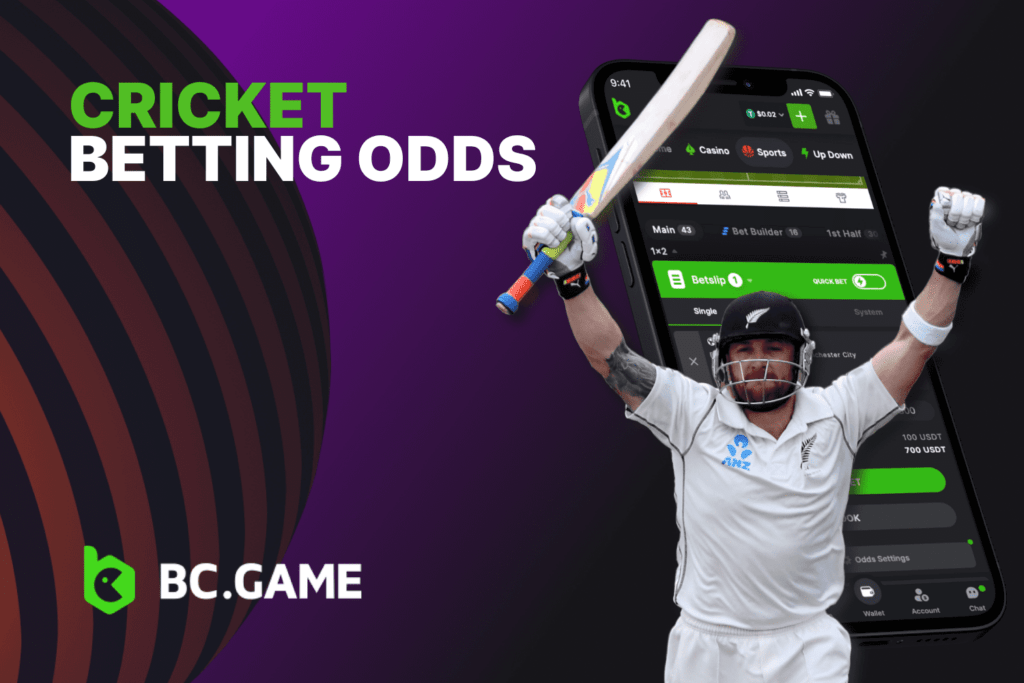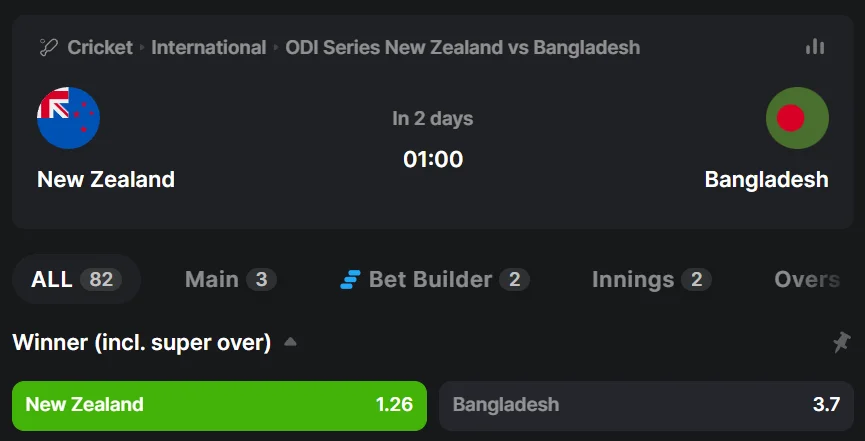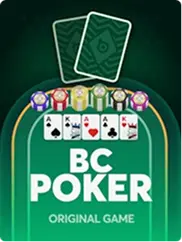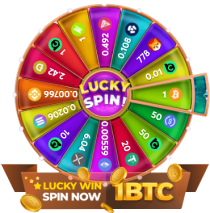
Cricket odds and betting lines aren’t just numbers, they’re the backbone of any smart betting strategy. Let’s get into it we’re gonna break down what these odds mean, how to read ’em, and how you can use ’em to up your game in cricket betting. Whether you’re a betting pro or just starting out, getting the hang of the odds is key to making better bets and maybe even cashing in on your cricket know-how. So, let’s roll up our sleeves and dig into the nitty-gritty of cricket odds live and betting lines.
Types of Odds
| ⬇️ Odds Type | 🔄 Format | 📑 Example |
| Fractional Odds | X/Y (e.g., 5/1) | Represents potential profit (Y) for a stake (X). For example, a bet of $10 at 5/1 odds would yield $50 in profit if successful |
| Decimal Odds | X.X (e.g., 6.00) | Indicates the total potential return, including the initial stake. For example, a bet of $10 at 6.00 odds would return $60 in total (including the $10 stake) if successful |
| Moneyline Odds | Positive/Negative (e.g., +500, -150) | Positive (+) odds show potential profit on a $100 stake. For example, +500 means you could win $500 on a $100 bet. Negative (-) odds indicate the amount you need to bet to win $100. For example, -150 means you must bet $150 to win $100 |
Understanding these odds formats is crucial for cricket betting, as it allows bettors to compare odds from different sportsbooks and make informed wagering decisions.

Understanding Probability
Basically, probability tells you how likely something is to happen, and bookies lean on it to set their odds. In the cricket world, you can use probability for all sorts of things like guessing if a team’s gonna win, if a player might knock out a century, or how many runs will be scored in an innings. Bookies crunch a lot of numbers, look at past matches, analyze team forms, and more to work out these probabilities and turn ’em into online cricket betting odds.
For us bettors, knowing a bit about probability is like having an extra tool in the toolbox. It helps you figure out if the bookie’s odds actually match what you think will happen. If you reckon something’s more likely to go down than the odds suggest, that’s your cue to consider betting on it. Bottom line, if you wanna do well in cricket betting, you’ve got to get good at understanding probabilities.
Fractional Odds
If you’re betting in the UK or Ireland, you’re probably gonna see a lot of fractional odds. These are the old-school way to show betting odds, and they’re still pretty popular around here. These odds are expressed as a fraction, such as 5/1 or 2/3, and they indicate the potential profit relative to the stake.
Here’s how to interpret fractional odds:
- Numerator (Left Number): The numerator represents the potential profit if the bet is successful. For example, in odds like 5/1, you would make a profit of £5 for every £1 wagered if your bet wins. So, if you bet £10 on 5/1 odds and win, you would receive £50 in profit plus your original £10 stake.
- Denominator (Right Number): The denominator represents the stake (the amount you bet). Using the previous example of 5/1 odds, the denominator is £1. So, if you bet £1 and win, you’d get £5 in profit, plus your £1 stake, for a total return of £6.
Fractional odds can be both positive and negative. So here’s the deal: if you see odds like 5/1, that’s the good stuff. Bet a quid and you could win five more. But if the odds are flipped, like 1/5, it’s a different story. You’d have to put down five pounds just to make a one-pound profit. Got it?
These odds are a bit different from decimal and moneyline odds, so understanding them is essential if you plan to bet in regions where they are commonly used.
Decimal Odds
Decimal odds, also known as European odds, are a widely used format for representing betting odds in many parts of the world, including mainland Europe, Canada, Australia, and New Zealand. These odds are expressed as decimal numbers, such as 2.00 or 3.50, and they provide a straightforward way to understand the potential return on a bet.
The decimal odds represent the total potential return on a bet, including both the profit and the original stake. For example, if you see odds of 2.00 and you bet $100, your potential total return is $200. This includes your original $100 stake, which means your profit would be $100.
Calculating the profit alone is easy with decimal odds. To calculate the profit, you simply multiply your stake by the decimal odds. In the example above, $100 * 2.00 = $200.
The simplicity of decimal odds makes them popular among bettors because it’s easy to determine how much you stand to win if your bet is successful. If the odds are 3.50, a $100 bet would result in a potential total return of $350 ($250 profit plus the original $100 stake).

Unlike fractional odds, which can be a bit more complex to calculate, decimal odds provide a clear picture of the potential returns, making them a preferred choice for many in the betting world.
Moneyline Odds
Moneyline odds, also known as American odds, are a common way of representing betting odds in the United States. They are expressed as either positive or negative numbers and are used for both sports betting and other forms of wagering. Moneyline odds indicate not only the potential profit but also whether a bet is an underdog or a favorite.
Here’s how to interpret positive and negative moneyline odds:
- Positive Moneyline Odds: Positive odds are typically associated with underdogs. They represent the potential profit on a $100 bet. For example, if you see odds of +250, it means you could potentially win $250 in profit on a $100 bet. The total payout on a winning bet would be your profit plus your original $100 stake.
- Negative Moneyline Odds: Negative odds are generally associated with favorites. They indicate how much you need to bet to make a profit of $100. For instance, if you encounter odds for cricket of -150, you would need to wager $150 to potentially win a profit of $100. The total payout on a winning bet would be your profit plus your original $150 stake.
Moneyline odds make it easy to understand the implications of a bet quickly. With positive odds, you can see how much you could win on a $100 bet. With negative odds, you can see how much you need to bet to win $100. These odds are particularly useful for those new to sports betting or for comparing odds across different sportsbooks.
Odds Formats Conversion
Converting odds between different formats is a common practice in sports betting, especially when bettors want to compare odds from various sources or understand the potential payouts in formats they are more familiar with. Here, we’ll discuss how to convert odds between three common formats: Decimal, Fractional, and Moneyline.
Decimal to Fractional
To convert decimal odds to fractional odds subtract 1 from the decimal odds.
Convert the resulting decimal into a fraction in its simplest form (reduce it).
Express the fraction with a “/” symbol.
Example: Decimal odds of 2.50
2.50 – 1 = 1.50
Convert 1.50 to a fraction: 3/2
So, 2.50 in decimal odds is equivalent to 3/2 in fractional odds.
Fractional to Decimal
To convert fractional odds to decimal odds, use the following formula:
Decimal Odds = (Numerator / Denominator) + 1
Example: Fractional odds of 5/4
(5 / 4) + 1 = 1.25 + 1 = 2.25
So, 5/4 in fractional odds is equivalent to 2.25 in decimal odds.
Moneyline to Decimal
Alright, if you’re dealing with Moneyline odds and you want to switch them to decimal, here’s a quick and dirty formula for you. Got a positive Moneyline?
Divide it by 100 and then add 1. If it’s negative, just take the absolute value, divide 100 by it, and add 1. Simple as that.
Example 1: Positive Moneyline odds of +250
(250 / 100) + 1 = 2.50 + 1 = 3.50
So, +250 in Moneyline odds is equivalent to 3.50 in decimal odds.
Example 2: Negative Moneyline odds of -150
(100 / 150) + 1 = 0.6667 + 1 = 1.6667 (rounded to 1.67)
So, -150 in Moneyline odds is equivalent to 1.67 in decimal odds.
Decimal to Moneyline
Converting decimal odds to Moneyline odds can be done as follows:
If the decimal odds are greater than 2.00, calculate Moneyline odds as (Decimal Odds – 1) * 100 for positive odds.
If the decimal odds are less than 2.00, calculate Moneyline odds as (-100) / (Decimal Odds – 1) for negative odds.
Example 1: Decimal odds of 3.50
(3.50 – 1) * 100 = 2.50 * 100 = +250
So, 3.50 in decimal odds is equivalent to +250 in Moneyline odds.
Example 2: Decimal odds of 1.67
(-100) / (1.67 – 1) = (-100) / 0.67 ≈ -149.25
So, 1.67 in decimal odds is roughly equivalent to -149 in Moneyline odds.
These conversions allow bettors to understand and compare odds more easily, regardless of the format in which they are presented.
Bookmaker Margins
Bookmaker margins, also known as the “vig” (vigorish) or “overround,” represent the built-in advantage that bookmakers have to ensure they make a profit. Look, if you’re betting, you’ve got to know about the margins. Why? Because it affects the odds you get, which in turn affects your possible winnings. Bookies set odds so they win no matter what happens in the game. They’re smart like that.
Want to figure out the margin yourself? Here’s the formula you need:
Margin = (1 / Decimal Odds for Team A) + (1 / Decimal Odds for Team B) – 1
So let’s say you’ve got a football game and both teams have decimal odds of 2.00. You’d work out the margin like this:
Margin = (1 / 2.00) + (1 / 2.00) – 1
Which is basically 0.50 + 0.50 – 1, and that gives you a big fat zero for the margin.
So, knowing this helps you understand how much the bookmaker is taking off the top. Keep an eye on those margins!
In this case, the margin is 0%, indicating a perfectly balanced book where the bookmaker doesn’t have an advantage.
However, bookmakers often build a margin into their odds to ensure a profit. Higher margins mean less favorable odds for bettors. It’s essential for bettors to compare odds from different bookmakers to find the best value.
Line Movement
Line movement refers to changes in the cricket betting odds or point spreads offered by bookmakers on a particular event. It’s a dynamic process influenced by various factors, including betting volume, injuries, weather conditions, and public sentiment. Understanding line movement is essential for bettors looking to capitalize on shifting odds.
There are two main types of line movement:
- Sharp Money: This occurs when professional bettors (known as “sharps”) place large bets on one side of an event, causing the cricket match odds to move. Bookmakers often react to sharp money quickly because these bettors are considered knowledgeable and influential.
- Public Money: Public bettors, often referred to as “squares,” tend to bet on popular teams or the favorite. When a large volume of public money comes in on one side, bookmakers may adjust the best cricket odds to balance their exposure.
Line movement can provide valuable insights into where the betting market is leaning. For example, if the current betting odds on an underdog become less favorable (e.g., +3 to +2.5), it could indicate that more bets are coming in on the underdog, suggesting public sentiment or sharp action. Bettors often study line movement to determine when and where to place their bets strategically.
Finding Value Bets
Identifying value bets is a fundamental skill for successful in cricket betting. A value bet is one where the probability of a particular outcome occurring is higher than the cricket bet odds offered by the bookmaker. In other words, it’s a bet that offers favorable odds compared to your assessment of the event’s true probability.
Here are some key steps to finding value bets:
Start by researching the teams, players, and factors that can influence the outcome of an event. Analyze historical data, team statistics, player performance, injuries, weather conditions, and more. The more information you have, the better you can assess the true probability of an outcome.
Based on your research, calculate your own probabilities for different outcomes. For example, if you believe Team A has a 60% chance of winning a match, convert this into odds (1 / 0.60 = 1.67 in decimal odds).
Compare your calculated odds to the odds offered by bookmakers. If your calculated odds are higher (i.e., you believe the probability is greater) than the bookmaker’s odds, it might be a value bet.
Pay attention to line movement, as discussed earlier. If you notice odds shifting in your favor, it can be a sign that others are also finding value in the same outcome.
Not every bet will present value, so be selective in your choices. Avoid betting for the sake of it and focus on situations where you genuinely believe the odds are in your favor.
Even with value bets, there are no guarantees. Proper bankroll management is crucial. Never bet more than you can afford to lose, and consider using a percentage of your bankroll for each bet.
Betting for value is a long-term strategy. Individual bets may not always win, but over time, if you consistently find value bets, you’re likely to come out ahead.
Keep detailed records of your bets, including your reasons for selecting each one and the outcomes. This helps you track your performance and identify areas for improvement.
Finding value bets is a skill that takes time to develop. It requires a combination of research, analysis, discipline, and patience. By consistently seeking out value in your bets, you increase your chances of long-term profitability in sports betting.
Bankroll Management with Odds
Look, if you wanna make it in the cricket betting game, there are two golden rules: get those odds down pat and handle your cash like a pro. First, let’s talk odds. You’ll see them in different styles decimal, fractional, moneyline, but they’re all trying to tell you the same thing: what’s the chance of something happening. Master the math behind converting these formats, and you’ll be leagues ahead.
Now, onto your money. You gotta treat your betting bankroll like it’s your baby. Figure out what chunk of change you’re cool with risking and then break it down into units. The size of these units will depend on your overall bankroll, and you’ve got to adjust that size according to different odds. Trust me, proper bankroll management is your safety net. It helps you ride out the rough patches so you can bet another day.
So, put those two things together knowing your odds and keeping a tight grip on your bankroll and you’ll be on your way to playing the long game in cricket betting. Keep those principles in mind, and you’re setting yourself up for better odds at actually making some dough in the long run.
Common Betting Mistakes In Cricket
Alright, let’s get real about the rookie mistakes that trip up so many people when it comes to cricket betting. First off, don’t let your heart call the shots. Betting on your favorite team ’cause you love ’em? Big no-no. That’s how you end up throwing good money after bad decisions.
Next up, don’t go doubling down to try and win back your losses. That’s the fast track to an empty wallet. Stick to your game plan and budget, and don’t make crazy bets you’ll regret later.
Also, you gotta do your homework. You wouldn’t take a test without studying, right? So don’t make bets without knowing what you’re talking about. Understand the teams, the players, and whatever else could swing the game. Skipping the research is like going all-in on a hunch not smart.
And last but not least, be a savvy shopper when it comes to odds and value. Don’t just jump on a bet because you think it’s a sure thing. You’ve got to weigh the risk and reward, and find those sweet spots where the bookies might be underestimating the real odds.
So there you go. Dodge these common pitfalls and you’ll already be ahead of the game. Keep your wits about you, stick to the data, and you’ll have a fighting chance at not just enjoying sports betting, but maybe even making it pay.
Using Odds to Build Strategies
Listen up, if you’re into betting, then odds cricket are your bread and butter. They’re not just random numbers, alright? They give you the lowdown on what’s expected to happen and how much dough you could make. So yeah, odds are kinda like your cheat sheet.
Ever heard of value betting? It’s when you’re basically acting like a Wall Street pro, but for sports. You compare what you think is gonna happen to what the bookies say. If your gut’s telling you something’s more likely than the odds suggest, that’s your cue to bet.
Then there’s this thing called arbitrage betting. Here’s the genius part: you’re betting on all outcomes of an event, but with different bookies. The goal? Make a profit no matter what happens. You’re just taking advantage of the bookies not agreeing on the odds.
And don’t even get me started on watching how odds change. If the odds suddenly shift, something’s up. Maybe there’s some breaking news or a whole lot of people are betting on the underdog. Either way, it’s a clue that you might wanna adjust your game plan.
Bottom line: odds are like your GPS in the wild world of betting. Get good at reading them, and you’ve got yourself a roadmap to potentially making some cash.
Conclusion
Alright, let’s wrap this up. Cricket betting isn’t just some sideline fun it’s like a whole other ball game, mixing the love of the sport with the high stakes of throwing down some cash. You can bet on everything from who’s gonna crush it in the next match to live bets as the game’s unfolding.
But hey, it’s not just about picking the team that’s on fire. You’ve gotta be on top of managing your funds, cutting your losses, and learning from those face-palm moments. It’s the long game that counts.
Cricket’s got a vibe that’s global, from World Cups to local showdowns. That means plenty of chances to bet, no matter how you slice it.
Now, a word to the wise: don’t let things get outta hand. Keep an eye on your money and don’t let your emotions bet for you. Responsible betting isn’t just good sense it’s how you stay in the game. It’s about doing your homework and keeping your cool. Put in the time to understand the game, the stats, and how betting works, and you’ve got a real shot at not just enjoying the game but maybe even making some extra change.
FAQ
To find the best betting odds, you need to compare different bookmakers. Each bookmaker sets their odds based on their analysis and the betting behavior of their customers. To ensure you get the best odds, sign up with multiple reputable bookmakers and regularly check their offerings for the event you’re interested in. Additionally, using odds comparison websites can be a valuable tool. These websites provide a side-by-side comparison of odds from various bookmakers, making it easier to identify the most favorable odds.
Knowing which odds are better involves understanding the concept of value in betting. Odds represent the probability of an outcome and the potential return on a bet. Favorable odds are those that offer a higher return relative to the risk. This doesn’t always mean choosing the highest odds. Instead, consider the likelihood of the event happening against the potential profit. Betting with value in mind means seeking odds that you believe are set higher than the actual probability of the event occurring.
To read cricket betting odds, simply look at the numbers provided by the bookmaker. These numbers indicate how much you can win relative to your bet. Higher odds mean a larger potential payout but usually come with a lower chance of winning, and lower odds mean a smaller payout but a higher chance of winning.













